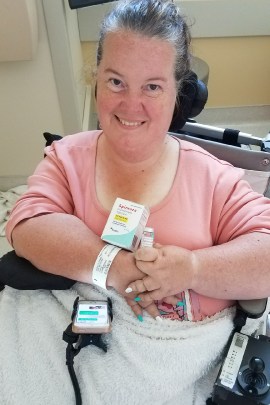Tammi Bradley jumped on her computer the minute she heard the news about the Food and Drug Administration’s approval of a drug targeting spinal muscular atrophy (SMA), a progressive muscle-weakening condition she’s had since childhood.
“That night, I wrote to all my neurology doctors and my personal physician, saying I was interested in obtaining this treatment,” recalled the 51-year-old Citrus Heights, Calif., resident.
The drug — Spinraza — costs $750,000 for the first year and $375,000 each year thereafter. The FDA, in granting approval in late December, said it was for use on children and adults with SMA, a sometimes fatal, genetic condition that often strikes infants and varies in severity.
But there’s a catch for older patients like Bradley: It was not tested in adults in the clinical trials leading to approval. As a result, some insurers won’t authorize it for adults.

Tammi Bradley takes a celebratory photo with the empty vial of her first dose of Spinraza on Aug. 1. (Courtesy of Tammi Bradley)
In Bradley’s case, it led to a tug of war with her health plan, which says it covers Spinraza “when determined to be medically necessary.”
Initially, coverage was denied. “As of today, there is no medical indication of Spinraza on patients over the age of 15,” said the June 2 letter she received from Kaiser Permanente. (Kaiser Health News is not affiliated with Kaiser Permanente.)
“It’s almost like age discrimination,” said Bradley, who has used a wheelchair all her life and fears that her breathing and strength will continue to decline. “I’m angry, I’m numb, I’m scared and I am dying.”
She appealed the decision to an outside reviewing agency overseen by the state, and it overturned Kaiser’s denial about two weeks later.
“I feel hope that I will actually live long enough to fulfill my dream of being a grandma someday,” Bradley said.
No one knows what effect the drug will have in adults with the genetic condition, which often begins in infancy when motor functions are still forming. Bradley has Type 2 SMA, which is generally diagnosed in older babies and toddlers. Onset of the disease can also occur in older children or teenagers.
While a few insurers cover the drug broadly, all set some kind of eligibility rules — most are focused on younger children because that’s the age group affected by the most common form of the disease, Type 1. Coverage for adults is less common.
Spinraza isn’t the only drug facing limits. Many treatments carry eligibility conditions that require patients and their doctors to get an OK by the insurer before starting treatment.
As prices grow, insurers want more details on the effectiveness of drugs and question whether their benefits justify their prices, said Steven Pearson, founder and president of the Institute for Clinical and Economic Review, a nonprofit that evaluates the value of medical tests and treatments for insurers and other clients.
With expensive drugs, those questions “are magnified in intensity by 10 times,” said Pearson.
Biogen, the maker of Spinraza, and patient-advocacy groups like Cure SMA believe the drug should work similarly in all patients.
Nevertheless, it’s more difficult to measure improvement in adults because they are past the developmental milestones, which provide straightforward markers to assess the progress of infants and toddlers taking the drug.
For adults, “it might be a change in stamina rather than strength,” said Kenneth Hobby, president of Cure SMA, and quantifying that is a challenge.
Asking insurers to pay for a drug without proof that it works is becoming a harder sell.
“Insurers in the past have said where there’s a rare disease, even if the drug was expensive, they wouldn’t blink,” said Diana Zuckerman, president of the National Center for Health Research, a nonprofit that reviews health research. “But obviously they can’t keep doing that if there is a pattern of FDA approving drugs based on zero evidence for some groups and companies charge these outrageous amounts of money for drugs that don’t cure.”
This story was produced by Kaiser Health News, an editorially independent program of the Kaiser Family Foundation.

